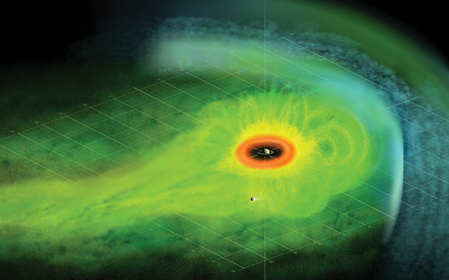Saturn
'Tis the Season -- for Plasma Changes at Saturn
 |
This is an artist's concept of the Saturnian plasma sheet based on data from Cassini magnetospheric imaging instrument. Image credit: NASA/JPL/JHUAPL
The paper, just published in the Journal of Geophysical Research, is led by Tim Kennelly, an undergraduate physics and astronomy major at the University of Iowa, Iowa City, who is working with Cassini's radio and plasma wave science team. In data collected by Cassini from July 2004 to December 2011, Kennelly and his colleagues examined "flux tubes," structures composed of hot, electrically charged gas called plasma, which funnel charged particles in towards Saturn. Focusing on the tubes when they initially formed and before they had a chance to dissipate under the influence of the magnetosphere, the scientists found that the occurrence of the tubes correlates with radio wave patterns in the northern and southern hemisphere depending upon the season. This seasonal effect is roughly similar to the way Earth's northern lights appear more frequently in the spring and autumn months.
Radio emissions have been used to measure Jupiter's rotation period reliably, and scientists thought it would also help them determine Saturn's rotation period. To their chagrin, however, the pattern has varied over the visits by different spacecraft and even in radio emissions originating in the northern and southern hemispheres. The new results could help scientists hone in on why these signals vary the way they do.
For more on the finding, go to: http://now.uiowa.edu/2013/03/telling-time-saturn
The Cassini-Huygens mission is a cooperative project of NASA, the European Space Agency and the Italian Space Agency. NASA's Jet Propulsion Laboratory in Pasadena, Calif., manages the mission for the agency's Science Mission Directorate in Washington. The radio and plasma wave science team is based at the University of Iowa, Iowa City, where the instrument was built. JPL is a division of the California Institute of Technology, Pasadena.
Credit: NASA
Saturn
'Tis the Season -- for Plasma Changes at Saturn
 |
This is an artist's concept of the Saturnian plasma sheet based on data from Cassini magnetospheric imaging instrument. Image credit: NASA/JPL/JHUAPL
The paper, just published in the Journal of Geophysical Research, is led by Tim Kennelly, an undergraduate physics and astronomy major at the University of Iowa, Iowa City, who is working with Cassini's radio and plasma wave science team. In data collected by Cassini from July 2004 to December 2011, Kennelly and his colleagues examined "flux tubes," structures composed of hot, electrically charged gas called plasma, which funnel charged particles in towards Saturn. Focusing on the tubes when they initially formed and before they had a chance to dissipate under the influence of the magnetosphere, the scientists found that the occurrence of the tubes correlates with radio wave patterns in the northern and southern hemisphere depending upon the season. This seasonal effect is roughly similar to the way Earth's northern lights appear more frequently in the spring and autumn months.
Radio emissions have been used to measure Jupiter's rotation period reliably, and scientists thought it would also help them determine Saturn's rotation period. To their chagrin, however, the pattern has varied over the visits by different spacecraft and even in radio emissions originating in the northern and southern hemispheres. The new results could help scientists hone in on why these signals vary the way they do.
For more on the finding, go to: http://now.uiowa.edu/2013/03/telling-time-saturn
The Cassini-Huygens mission is a cooperative project of NASA, the European Space Agency and the Italian Space Agency. NASA's Jet Propulsion Laboratory in Pasadena, Calif., manages the mission for the agency's Science Mission Directorate in Washington. The radio and plasma wave science team is based at the University of Iowa, Iowa City, where the instrument was built. JPL is a division of the California Institute of Technology, Pasadena.
Credit: NASA






